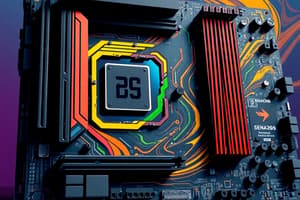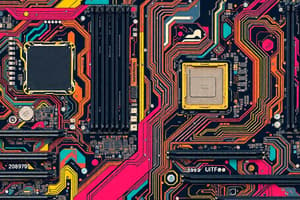Podcast
Questions and Answers
How does the ATX form factor improve air movement compared to its predecessors?
How does the ATX form factor improve air movement compared to its predecessors?
By strategically positioning the power supply to facilitate better airflow.
Why was the BTX form factor introduced and what specific design goal did it aim to achieve?
Why was the BTX form factor introduced and what specific design goal did it aim to achieve?
It was introduced to address heat issues from faster CPUs and powerful graphics cards, aiming to improve cooling through a single airflow design.
What is the primary function of the Northbridge chip in a motherboard chipset, and what characteristic necessitates its own heatsink?
What is the primary function of the Northbridge chip in a motherboard chipset, and what characteristic necessitates its own heatsink?
The Northbridge chip manages high-speed communications, like AGP and memory, and gets its own heat sink due to dealing with memory and generating a lot of heat.
Explain how the LPX and NLX form factors optimized space utilization differently from AT motherboards.
Explain how the LPX and NLX form factors optimized space utilization differently from AT motherboards.
Describe what 'soft power' is in the context of ATX motherboards and how it differs from earlier power management methods.
Describe what 'soft power' is in the context of ATX motherboards and how it differs from earlier power management methods.
How does the role of the Southbridge chip differ from that of the Northbridge chip?
How does the role of the Southbridge chip differ from that of the Northbridge chip?
What are two primary functions determined by a motherboard's chipset?
What are two primary functions determined by a motherboard's chipset?
What is the primary design goal of the BTX form factor regarding airflow and cooling?
What is the primary design goal of the BTX form factor regarding airflow and cooling?
What is the purpose of the CMOS backup battery on a motherboard?
What is the purpose of the CMOS backup battery on a motherboard?
Explain why it's important to choose a PC case that matches the motherboard's form factor.
Explain why it's important to choose a PC case that matches the motherboard's form factor.
Flashcards
What is the Motherboard?
What is the Motherboard?
The main circuit board that connects all the parts of your computer together.
What is a Form Factor?
What is a Form Factor?
Determines the layout and dimensions of a motherboard, ensuring compatibility with the case and power supply.
What is AT (Advanced Technology)?
What is AT (Advanced Technology)?
An older form factor where processor, memory, and slots are in line, now obsolete due to its limited external ports.
What is BTX (Balanced Technology Extended)?
What is BTX (Balanced Technology Extended)?
Signup and view all the flashcards
What is ATX (Advanced Technology Extended)?
What is ATX (Advanced Technology Extended)?
Signup and view all the flashcards
What is a Chipset?
What is a Chipset?
Signup and view all the flashcards
What is Northbridge?
What is Northbridge?
Signup and view all the flashcards
What is Southbridge?
What is Southbridge?
Signup and view all the flashcards
Study Notes
Motherboard Overview
- The motherboard is a fundamental component of a computer.
Form Factors
- The form factor determines a motherboard's layout and dimensions.
- Motherboards generally have a rectangular shape but vary in size and built-in components.
- A PC's case and power supply are related to the form factor and must have matching connectors to the motherboard.
- Standard form factors include AT, Baby AT, LPX, NLX, ATX, and BTX, along with variations.
- Most PC cases are designed for a single form factor.
AT Form Factor
- AT stands for Advanced Technology and is also known as Full AT.
- AT is now obsolete.
- IBM invented the AT form factor in the early 1980s, and it was the predominant form factor through the mid-1990s.
- The processor, memory, and expansion slots are aligned in the AT form factor.
- AT had a large keyboard port.
- A limited number of external ports presented a problem, as the only devices plugged into an average PC were a monitor and a keyboard.
- AT had to be replaced as more devices were connected to PCs.
- Motherboards catered to only a monitor and keyboard, unlike today's average PC, which includes a keyboard, mouse, printer, speakers, monitor, and USB devices.
- As technology improved the demand increased for smaller PCs.
- Manufacturers created smaller motherboards by placing the same components in a smaller area called Baby AT.
- Baby AT had problems with component placement, which resulted in limited expandability and overheating.
LPX and NLX Form Factors
- The demand for new standard form factors arose as new components were added.
- LPX (Low Profile Extended) was one successful slimline factor and was later replaced with NLX (New Low Profile eXtended).
- A small riser exists in the center of the form factor, where cards are horizontally attached to optimize space use.
ATX Form Factor
- ATX stands for Advanced Technology Extended.
- ATX addressed the demand for a new form factor with more standard connectors and flexibility.
- The ATX form factor was created in 1995.
- It started slowly but became the most commonly used form factor, surpassing AT by around 1998.
- The ATX form includes many improvements over AT.
- Better air movement is enabled by the placement of the power supply.
- CPU and RAM placement allows for easier access.
- RAM is placed closer to the Northbridge and CPU, improving performance over AT boards.
- PS/2 ports were introduced as new, smaller keyboard and motherboard ports.
- The ATX motherboards use soft power and can be turned on and off with soft power.
- ATX power switches comprise only a pair of small wires leading to the motherboard, unlike the thick power cords used in AT systems.
- Later version of ATX include microATX and FlexATX, with the latter being the smallest.
BTX Form Factor
- BTX stands for Balanced Technology Extended.
- BTX was introduced because heat remained a problem with faster CPUs and powerful graphics cards, even with improved ventilation.
- BTX aims to be the coolest form factor through design changes made to improve cooling by managing heat with a single airflow.
- Major design changes of BTX form factor include:
- The I/O Ports and expansion slots have changed position.
- The CPU has been moved to be at the front of the motherboard to get cool air from the front of the case.
- Introduced a new fan & heatsink system called the thermal unit.
- The thermal unit blows air directly outside of the case, unlike the fan in the ATX, which blows air inside of the case. -BTX is available in BTX, micro BTX, and picoBTX versions.
Chipsets
- Every motherboard has a chipset.
- The chipset defines many aspects of the motherboard, like processor and memory type support, and what internal and external devices the motherboard can support.
- Chipset features, performance, and stability vary greatly and are crucial in purchasing or recommending a motherboard.
- Chipsets facilitate communication between the CPU and other system devices
- Chipset components are relatively centralized on the motherboard.
- Most modern chipsets consist of Northbridge and Southbridge chips.
Northbridge & Southbridge
- The Northbridge chip handles AGP and memory communications.
- Northbridge chips deal heavily with memory and therefore require heatsinks.
- The Southbridge chip manages onboard peripherals like audio, storage drives, networks, and expansion buses.
- Most Southbridge chips do not need heatsinks.
- The Northbridge is responsible for high-speed components, while the Southbridge is responsible for low-speed components.
Chipset Manufacturers
- Both Intel and AMD create chipsets
- They lead the market despite competition from VIA Technologies and NVIDIA Corporation.
- Chipset manufacturers do not always use the terms Northbridge and Southbridge, and may use their own chip names.
- AMD uses the terms Northbridge and Southbridge, while Intel uses Memory Controller Hub and I/O Controller Hub respectively.
Studying That Suits You
Use AI to generate personalized quizzes and flashcards to suit your learning preferences.



